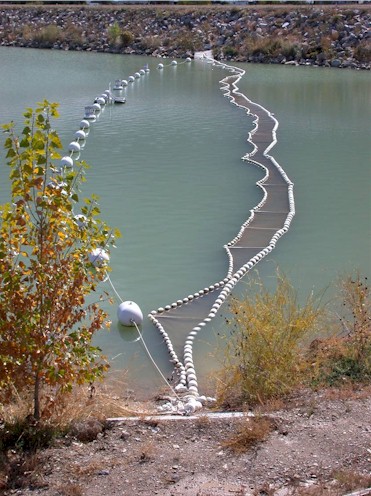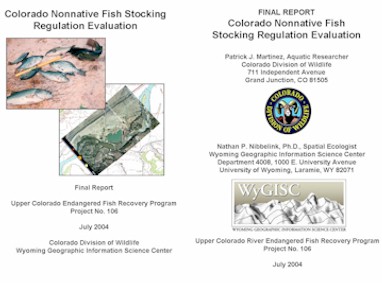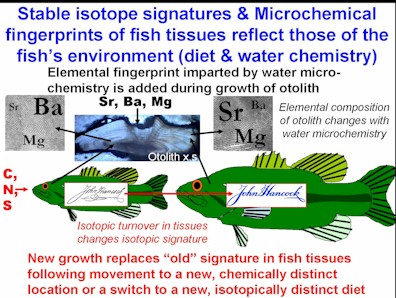The Recovery Implementation Program for Endangered Fish Species in the Upper Colorado River Basin, finalized in 1987, seeks to protect and restore populations of the following endangered species:
Colorado pikeminnow Ptychocheilus lucius,
Humpback chub Gila cypha
Bonytail chub Gila elegans
Razorback sucker Xyrauchen texanus
Principle recovery strategies include:
Habitat protection and management through flow manipulations
Propagation and stocking of endangered fishes
Development and restoration of critical habitat features
Controlling populations and stocking of nonnative fishes
The West Slope Warmwater Fisheries Project is related to this latter component of the Recovery Program. The project was implemented to help identify and develop ways to maximize angling opportunity for nonnative warmwater sport fish while ensuring the compatibility of this activity with programs to reduce and control nonnative fishes in riverine habitats of native fishes. Recent and current research topics are briefly described below.
Highline Lake spillway barrier net
Installed using funding from the Recovery Program in 1999, a 363 foot long and 19 foot deep net proved successful in controlling the escapement of fish over the spillway of Highline Lake in Highline State Park near Grand Junction. Fabricated from the high tech fiber Dyneema, the net has proven to be durable, remaining in service for five years, and provides the opportunity to monitor all performance facets of a large-scale net. The net’s installation and its maintenance by State Parks’ personnel facilitated the first ever, and ongoing, stocking of largemouth bass and bluegill into the reservoir to improve its fishery. Summaries of the net’s performance, evaluation, and maintenance can be found in a series of annual reports dated 2001, 2002, and 2003, that were prepared by CPW aquatic researcher Pat Martinez. See Figure #1.

Figure #1. Spillway barrier net, 363 feet long and 19 feet deep, installed in 1999 at Highline Lake in Highline State Park near Grand Junction.
Evaluating Colorado’s nonnative fish stocking regulations
Adoption of the Procedures for Stocking Nonnative Fish Species in the Upper Colorado River Basin by the Colorado Division of Wildlife and other agencies participating in the Recovery Program was intended to ensure that the stocking of nonnative sport and non-sport fishes by public and private interests was consistent with efforts to recover endangered fishes. The CPW translated these procedures into regulations in 1990 and initiated an evaluation of the regulation’s effectiveness using a GIS framework to examine public and private stocking records in western Colorado and pond and backwater fish sampling data collected within critical habitat for endangered fishes along the Colorado River in the Grand Valley. A 2004 report by CPW aquatic researcher Pat Martinez and aquatic ecologist Nate Nibbelink of the Wyoming Geographic Information Science Center at the University of Wyoming entitled Colorado Nonnative Fish Stocking Regulation Evaluation summarizes this research. See Figure #2.

Figure #2. Cover pages for final report summarizing investigation of public and private stocking activity in relation to the distribution and density of select nonnative fishes in backwaters of the Colorado River in the Grand Valley.
Assessing the utility of stable isotope signatures in Colorado River ponds and backwaters
Naturally occurring isotopes of carbon and nitrogen were analyzed in fish tissues to determine their capacity to distinguish top predator vs. prey species and identify fishes that had migrated from ponds into backwaters. Results showed that largemouth bass, green sunfish and black crappie were top predators in both ponds and backwaters. Further, differences in isotopic signatures between ponds and backwaters showed promise for tracking the movements of nonnative fish at some locations. The research, performed in cooperation with Colorado State University (CSU) is available in the following publication: Martinez, P. J., B. M. Johnson, and J. D. Hobgood. 2001. Stable isotope signatures of native and nonnative fishes in upper Colorado River backwaters and ponds. The Southwestern Naturalist 46:311-322. See Figure #3.

Figure #3. Abstract for Stable Isotope Signatures of Native and Nonnative Fishes in Upper Colorado River Backwaters and Ponds.
Examining the life history and predatory demand of smallmouth bass in the Yampa and Colorado Rivers
The proliferation of nonnative smallmouth bass in the Yampa River has been associated with the decline of its small-bodied fishes, both native and nonnative, in several reaches of the river. To apply a bioenergetics model to quantify predation by smallmouth bass, their growth rate had to be determined and an estimate of their abundance was required. Ages of smallmouth bass were determined from otoliths and John Hawkins of CSU provided an estimate of smallmouth abundance. Using existing data for channel catfish and northern pike in the Yampa River, the predatory demand by smallmouth bass was compared to the predation demand by these two other nonnative sport fish in cooperation with CSU (Dr. Brett Johnson). Initial results show that smallmouth bass potentially consume 3 to 10 times more fish than either channel catfish or northern pike. Examination of stomachs from Yampa River smallmouth bass currently shows 10% fish by weight in their diet, but it is believed that in the years preceding the decline of the river’s small-bodied fishes this percentage was much higher. In the Colorado River where smallmouth bass are more recently invading and small-bodied fish remain abundant, fish make up over 70% of the smallmouth bass diet by weight. These initial findings are described in the 2004 annual report by CPW aquatic researcher Pat Martinez. See Figure #4.

Figure #4. Nonnative, predatory sport fish found in the Yampa River (channel catfish, smallmouth bass and northern pike), and an otolith from a Yampa River smallmouth bass that has been transversely sectioned and polished to reveal 14 annuli (this 446 mmTL, 1540g or 17.5 inch, 3.4 pound smallmouth bass was 14 years old!).
Exploring origins of nonnative centrarchids in the Colorado River using microchemical analyses
In cooperation with CSU (Dr.s Brett Johnson and Greg Whitledge), water and otolith microchemistry are being applied to track the origins of nonnative centrarchids, largemouth bass, smallmouth bass, green sunfish, black crappie and bluegill, in the Colorado River in the Grand Valley. Primary objectives of this research are to establish elemental markers to distinguish between fish originating in ponds vs. backwaters, estimate the proportion of fish of either origin in backwaters, and identify point or reach sources of these fishes. Given the top predator status of most of these species, determining their origins will facilitate improved ecological and economical efficiency in controlling their numbers and reducing their detrimental effects on native and endangered fishes. See Figure #5.

Figure #5. Diagram illustrating potential utility of stable isotope signatures in fish muscle tissue and microchemical fingerprints in otoliths for identifying the origins of fishes moving among aquatic habitats, for example, from floodplain ponds into a backwater within critical habitat for endangered fishes.

